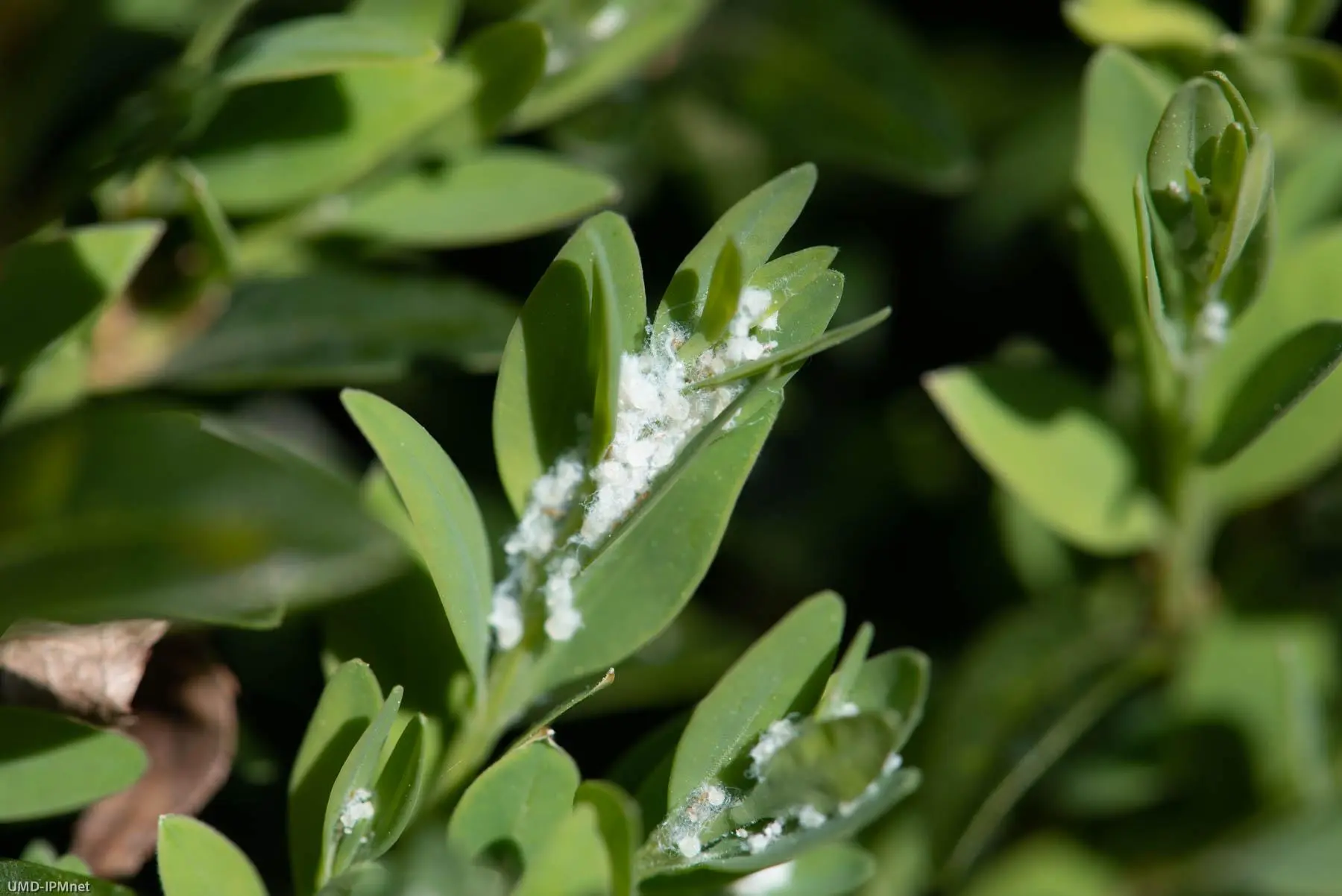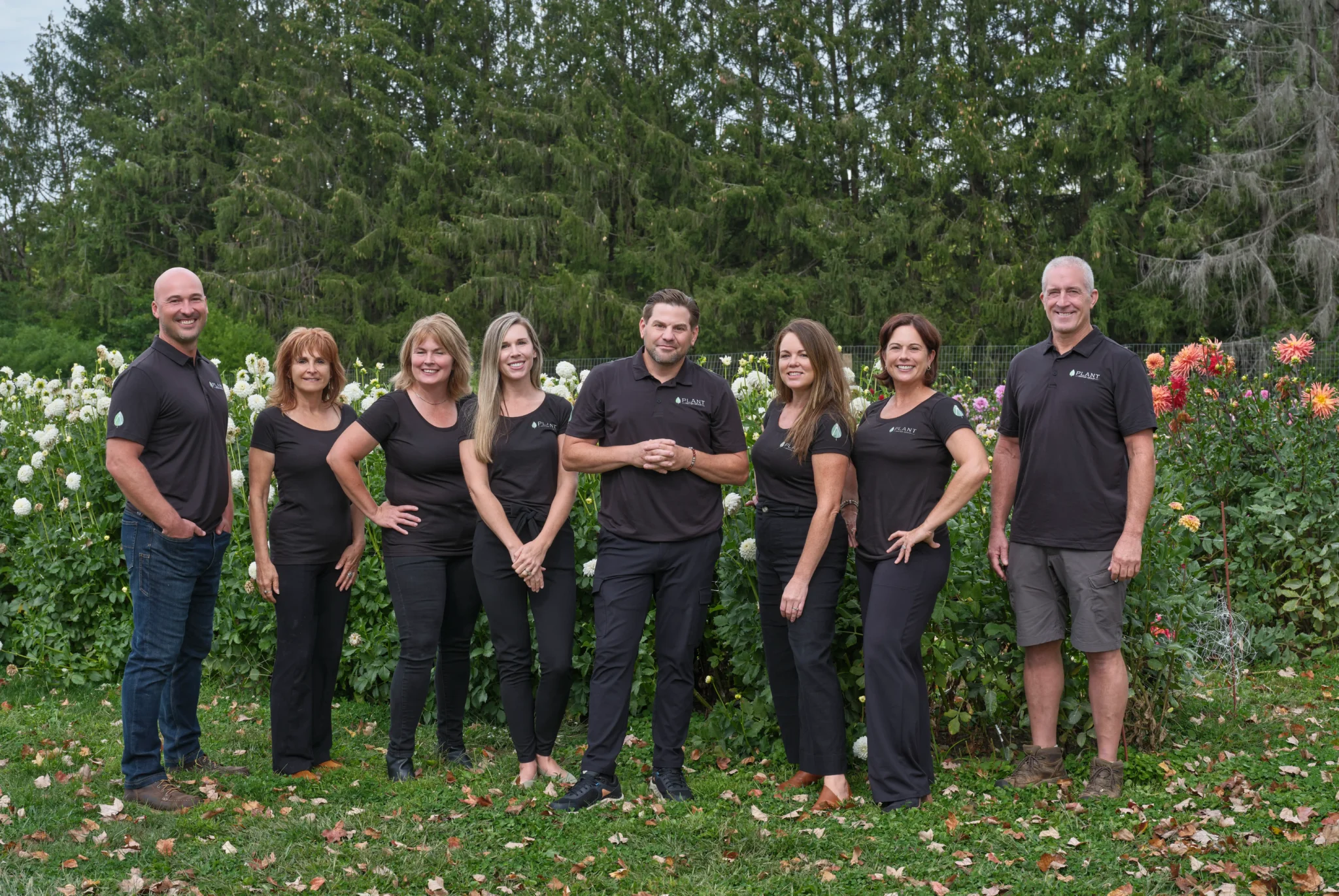Expert Tips from a Luxury Landscape Company for Boxwoods
By Kathy Glassey
Boxwoods are a signature element of refined garden design—prized for their evergreen foliage, sculptural elegance, and year-round structure. Whether forming crisp hedges, formal parterres, or topiary art, boxwoods are a favorite of luxury homeowners and professional landscape designers alike.
However, even the most carefully maintained boxwoods are vulnerable to a growing list of pests and diseases. At Plant Design Group, a leading landscape designer and supplier of boxwood hedge (Plant Design Group installed many thousands of foot of hedge every year!), we observe that expert trimming and pruning, a preventative focus on plant and soil health, and early detection are essential to preserving the beauty of these timeless plants.
Here’s what every homeowner needs to know about the most common boxwood threats—and how to protect your investment.
1. Boxwood Psyllid (Psylla buxi)
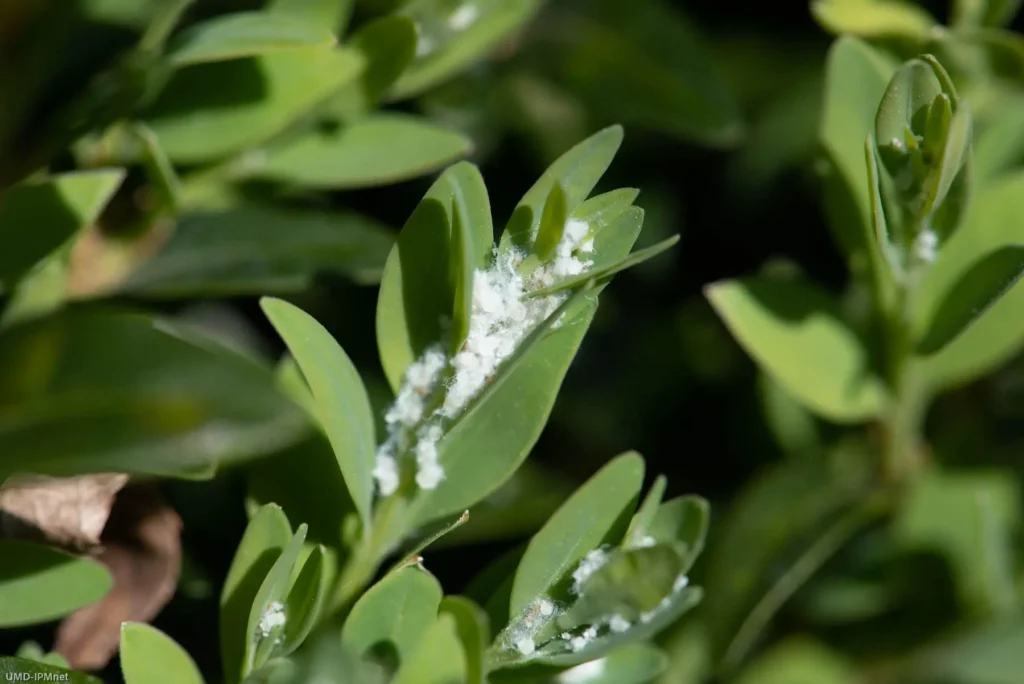
Photo: C. Carignan, UME
Symptoms to Watch For:
- Cupped or curled new leaves at stem tips
- White waxy residue from nymphs
- Stunted shoot growth
Impact: Primarily cosmetic, but repeated infestations can reduce plant vigor and shape.
Our Recommended Treatments:
- Prune and remove affected tips in early spring.
- Apply systemic insecticides before new growth begins.
- Use horticultural oils to suppress overwintering eggs.
Luxury Landscape Tip: Annual monitoring and gentle pruning are essential—this aligns with our proactive care philosophy used by top-tier landscape designers like Plant Design Group.
2. Boxwood Blight (Calonectria pseudonaviculata)
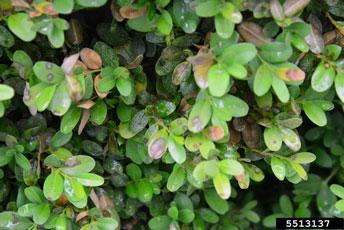
Photo by David Clement; University of Maryland
Why It Matters:
This aggressive fungal disease can and will devastate entire boxwood plantings if left untreated.
Key Symptoms:
- Rapid leaf drop, especially from the base up
- Dark leaf spots with distinct margins
- Black streaks on green stems
- Bare lower branches with only green growth on top
Control Strategies:
- Immediately remove and destroy infected plants—never compost.
- Disinfect tools between cuts.
- Avoid overhead watering and promote airflow.
- Apply preventive fungicides (e.g., chlorothalonil, thiophanate-methyl).
Design-Forward Solution: Select blight resistant cultivars—we integrate these into sustainable planting designs for lasting beauty.
3. Boxwood Leafminer (Monarthropalpus flavus)
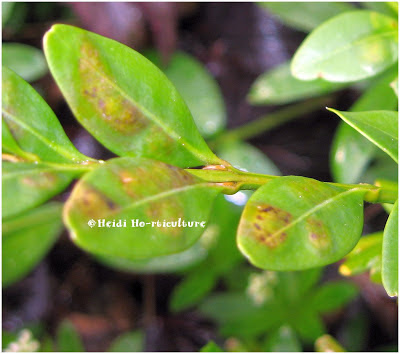
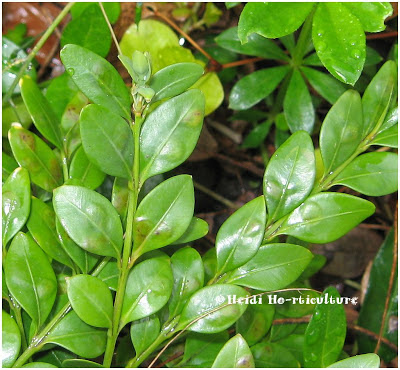
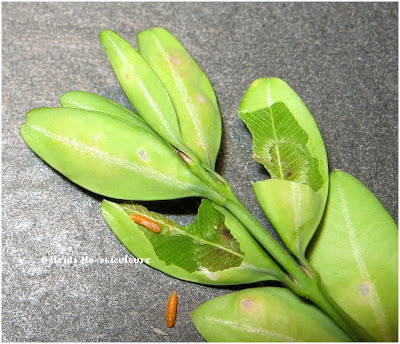
Photos from Heidi Ho-rticulture
The Most Common Pest of Boxwoods
Warning Signs:
- Blistered or swollen leaves
- Orange larvae visible inside leaves
- Premature leaf drop
Our Strategy:
- Apply systemic insecticides when adult flies emerge (late spring).
- Prune infested growth before larvae hatch.
Client Care Note: At Plant Design Group, we time all treatments according to seasonal cycles, ensuring maximum effectiveness with minimal disruption to your garden aesthetics and beneficial insect hatches such as lady bugs and parasitic wasps.
4. Boxwood Mite (Eurytetranychus buxi)
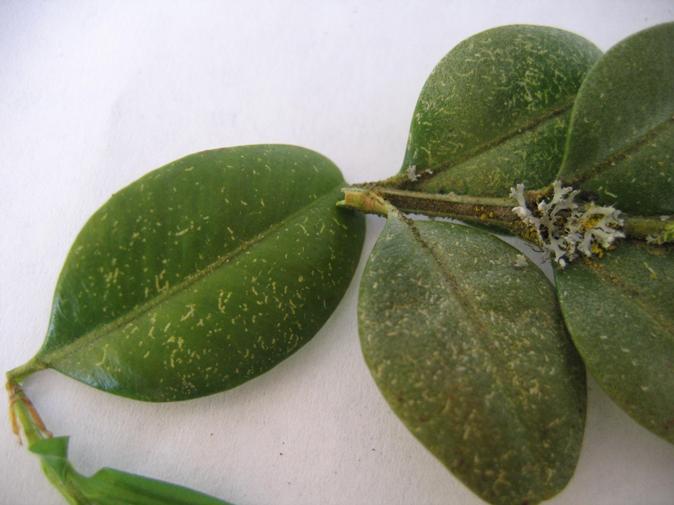
Photo: Karl Puls, Oregon Department of Agriculture
Subtle Yet Stressful
What to Look For:
- Fine speckling or bronzing on leaves
- Rough, sandpaper-like texture
- Visible mites under magnification
Treatment Options:
- Use a strong stream of water to dislodge mites.
- Apply horticultural oils or miticides in warm weather.
Luxury Landscape Insight: While often considered a minor pest, we address even subtle issues to maintain the pristine appearance expected in high-end landscapes.
5. Volutella Blight (Pseudonectria rousseliana)
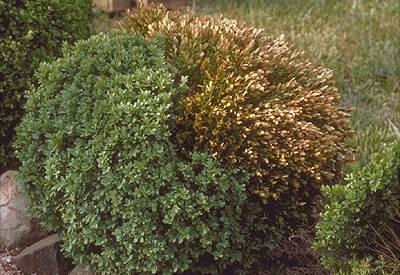
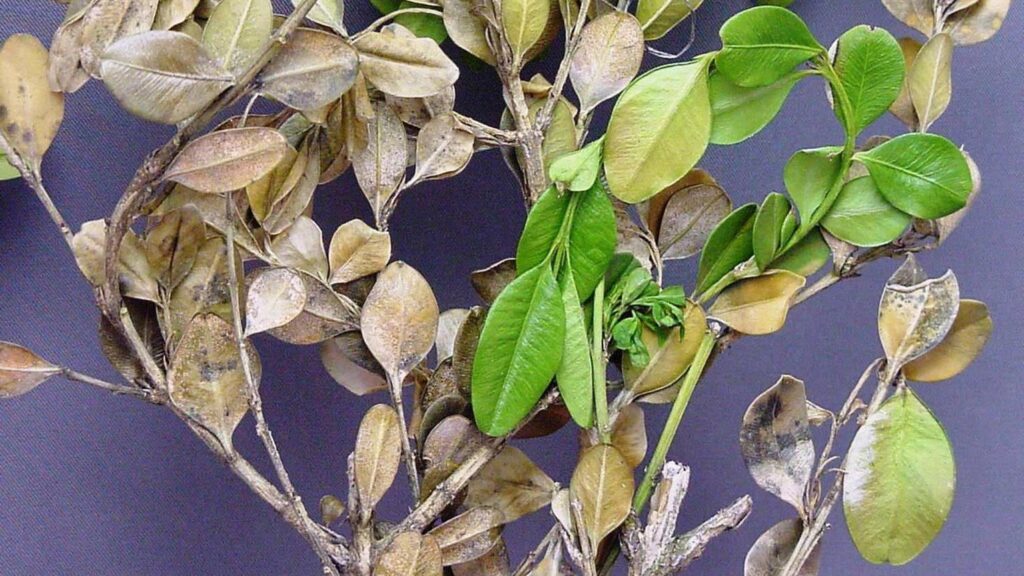
Photo: Paul Bachi, University of Kentucky Research and Education Center, Bugwood.org
Frequently Misidentified as Boxwood Blight
Symptoms Include:
- Yellowing leaves and branch dieback
- Orange or salmon-colored spores during humid periods
Control Plan:
- Prune and discard infected branches.
- Disinfect tools between cuts.
- Use copper-based fungicides preventatively.
- Improve air circulation and soil drainage.
Proactive Boxwood Care from a Trusted Landscape Designer
Healthy boxwoods start with intelligent planning, and that’s where an experienced landscape designer truly shines. At Plant Design Group, we take a comprehensive, concierge approach to boxwood care—designing not only for form and function but also for longevity and resilience.
Our Proven Preventative Protocols Include:
1. Smart Site Selection
- Well-draining soil only—boxwoods do not tolerate “wet feet.”
- Adequate spacing and sunlight to prevent fungal issues.
2. Thoughtful Watering
- Deep, base-level watering only—no overhead irrigation.
- Organic mulch applied carefully to retain moisture (never touching the stems).
3. Seasonal Pruning
- Winter or early spring is ideal for shaping and removing weak growth.
- Avoid heavy summer pruning to prevent frost-sensitive flushes.
4. Balanced Fertilization
- Use a slow-release, balanced fertilizer or soil conditioner in spring such as a Biochar with Humic and Fulvic Acids like Vital Blend
- Emphasize soil biology—healthy soil equals healthy shrubs. If there is a problem- we can test for all kinds of pests down to chemistry, microbes and bacteria to get to the root cause.
- Avoid over-fertilizing with nitrogen rich fertilizers, which can make plants more disease-prone.
Partner with a Landscape Company for Boxwoods That Exceed Expectations
Boxwoods are an investment in timeless beauty—but like any luxury feature, they require skilled stewardship. If your landscape includes boxwoods, or you’re considering incorporating them into a new design, trust the team at Plant Design Group- your premier landscape company to supply your boxwood hedges and an award-winning landscape designer.
Schedule a Consultation Today
Let our horticultural experts design a preventative care plan or rejuvenate struggling boxwoods with precision and discretion.
Visit www.plantdesigngroup.com
Serving Newtown, Doylestown, New Hope, and Surrounding Estates
Kathy Glassey is an ISA Certified Arborist (PD-2972A) and a valuable member of the PLANT Design Group/Kelly Grow team, seen here diagnosing and treating boxwood hedges with her magnifying glass. She has 35 years of experience working with turf, plants, shrubs, and trees, along with a passion for plant health and soil health.


